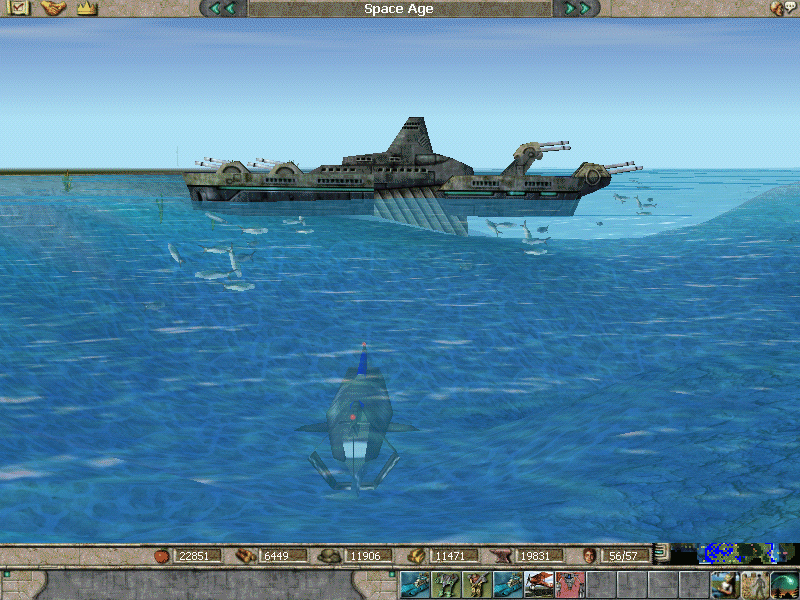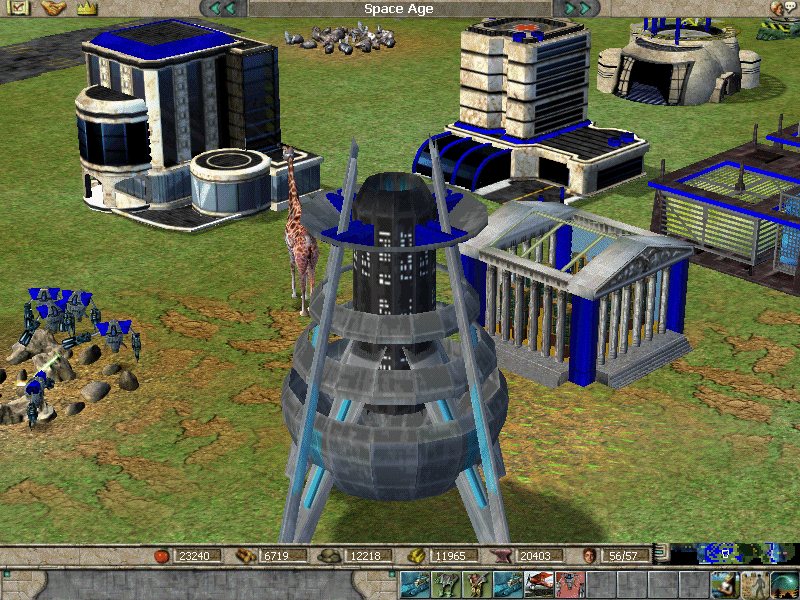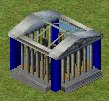Best viewed in 800x600 resolution
This page is dedicated to Sierra's awesome
game Empire Earth and the add-on pack The Art of Conquest.
I hope to be able to allow people to see just how vast this game really
is.
I also hope to be able to provide much information about the many facets
of this fascinating game.
I am not designing this to be a be-all end-all strategy guide or to
be anything similar.
I am designing this really to show off Empire Earth's capabilities
as well as provide information
that should prove helpful to people interested in this game. A 'promotion'
so to speak.
As such I am trying to avoid giving away game secrets but am more trying
to provide
others with the 'basics' that should help get the average (or lesser)
player through with minimal hair loss.
I don't plan on covering strategies for the campaigns because I
feel for that there is already an
excellent strategy guide available
to help with those (and I recommend it to those interested
in the numbers and such for unit
hit points, attack, as well as campaign walkthroughs).
What I plan on is a walkthrough of the basic game mechanics and basic
strategies that
are already available via the included manuals, readmes, and posters
but only available there in a less concise
format (deductive reasoning to most). While explaining this info, why
not exploit some eye candy as well.
Well, the eye candy isn't that great but should give you an idea as
to what the game looks
like zoomed way out. Less detailed graphics means shorter page loading
times for us
56K modem users (yes, we still exist or at least I do anyway). The
graphics do show that
Empire Earth is scaled fairly well between people and building size.
All pictures on this site
use the same scale throughout. Empire Earth does allow you to zoom
in to get a closer
look like so:

What a fine kettle of fish, eh? (Hammerhead Submarine vs. Leviathan Battleship)

A giraffe? In this neck of the city?
See how long it takes to load the page though (if using a modem). The
graphics of the game are MUCH better
than what is shown on this site. But with better graphics comes longer
page load times. I prefer to use less detailed
(and therefore smaller file sized) graphics for this reason.
See?  A giraffe and a
United States Trade Center
A giraffe and a
United States Trade Center  with an Iron Mine
with an Iron Mine ![]() .
.
I plan on breaking this all down by epoch (from I to XV) as well as
by substance issues
(like Wonders, Resources, and such).
I feel by breaking it down this way, most can understand things much
better.
Of course during gameplay, having an epoch or more advantage over an
opponent can really make things easier for you but on the same token,
having an epoch or more deficit with your opponent can spell death
but
is still not a certainty. Through unit upgrades and other improvements,
you
can be behind an epoch or more yet still be stronger. One of the many
more
fascinating aspects of Empire Earth. You can be 'behind' in epochs
but still be
ahead. There's no steadfast rule for success or failure but there are
basics,
that if learned, mean that the game will become much more enjoyable.
I hope to help provide those basics for you on this site.
First off, there are different games within this game.
The differences are covered well in chapter 3 of the Empire
Earth manual. Here is some added
information to what is there in chapter 3.
First, setting the army number in random map and multiplayer
games can be very crucial to gameplay
decisions. Less armies available means that you need
to balance resource gathering with military,
whereas large army sizes means less management of your
staff between resource/military will be needed.
This knowledge comes with experience and becomes a big
factor later on with many players as they
become more advanced. With small army size, many kick
in resource gathering to start then shift to
military production which means starting out focusing
your resources on creating citizens to collect
resources, and as you collect more resources, you create
more citizens to get the resources coming in
quicker. The down side is that citizens are not that
great at defending against military units. Which leads
to the "rush" technique where a player puts their first
resources into a military rather than citizens. It is
known as a "rush" because the player using this technique
has to rush their first few military units over
to the opponent to do the most damage BEFORE the opponent
hopefully has a chance to create a
counterattack. If successful, a rush can pretty much
destroy someone before they get a chance to start.
If unsuccessful, it usually means that the person trying
the rush can probably get wiped out early
because they sacrificed making citizens and their economy
in an unsuccessful attack and are now behind
because they lost military and also did not develop a
better economy. Lesson, always try to balance out
your gameplan. Try to focus on ALL aspects instead of
just one. If you make too many citizens, you
have too few military (and are therefore a target for
someone with more military strength). If you focus
too much on military, you can't upgrade nor build as
fast as others and therefore your military becomes
weak. Weak means death. You need the resources to build
a military and upgrade the military. You
need the military to protect your resources. It is a
two way street and if you over emphasize one and not
the other, you become weaker than someone who has a balanced
mix of economy and military.
So, you need to understand military and economy. They
work hand in hand. You need the military to
protect your economy and the economy to create and develop
your military. That is pretty much the
basics and basis for most military games, management
of resources. You have your economic resource
and your military resource and must learn to use them
together to make your people strong. Balanced
also does not really mean 'equal' but more that each
works well together. Too many resources coming in
without something useful to protect those resources coming
out, means disaster. Likewise, not enough
people collecting the resources you need means that you
can't build as good a military, which means that
you can't protect your resource gathering as well, which
means weak again.
So, resources must work together with the military. But
also, certain resources are more crucial at times
than others. If building atomic bombers, you need lots
of gold and iron. If building ships, then you need
wood with gold and/or iron depending on the ship. remember
also, to try and keep a balanced force and
to not try to rely on one unit. One unit is easy to counter
and also makes you weak. Atomic bombers are
powerful but if they keep getting shot down out of the
sky before they can drop an atomic bomb to
cause damage, they then become a waste. Battleships are
great but they stink against submarines. Each
unit has a nemesis which is why balancing becomes important.
Different epochs lead to different
strategies though because each epoch has its own units
and therefore its own strategy. Much tougher to
knock down a wall with a board (Sampson) than with an
atomic bomb. You wanna be that guy with the
atomic bomb while the other guy just has a stick in his
hand.
Well, how about a talk on resources now? OK go here .
Resources alone won't get you a win, BUT it will get you
started. I mean you can have your citizen
toss a chunk of gold at the enemy but it would be better
if you used that gold to build stronger military
units. You collect resources for a reason and that reason
is to kick butt with cool units and awesome
upgrades and unit improvements.
Another note is about "combos" or combinations of units.
Probably my favorite is the
combination of War Elephants and Elephant Archers. Lots
of hit points and some range.
Elephant archers are a kind of combo in their own way
with range AND hit point advantages
over most other units. Another combo that I'll mention
a lot is the spear and archer combo.
The archer's basic nemesis is the sword unit and the
sword unit's nemesis is the
spear unit. The spear unit gets used as a barrier between
the archer and would-be
attackers of your archers. A water combo is the submarine
and battleship combo.
Battleships pretty much annihilate most other boats but
subs make quick work of
battleships. Battleships can't attack subs at all. Using
fighter/bomber planes to take out
air resistance for your Atomic Bombers is another type
of combo as well. There is
also another water based trio of carriers, battleships
and subs which are really tough
to take on. In the Space epoch, Capitol Ships and Space
Carriers make a good combo.
Also, balloons, and the Spy Satellite* make excellent
spotters for many ranged infantry
like mortars and artillery. Snipers also work well as
spotters (since they are invisible until
within range). Using different units to strengthen each
other and protect one another
is always a good strategy. Having HUGE armies is always
a plus as well. Unit
relationships, ugrades, and so on aren't everything but
can help give you an edge in
most games. There's always that guy with 200 Clubmen
who takes out your 5
tanks with ease. When in doubt, max things out.
Most of us "old" strategy gamers take our basic knowledge
for granted. From much
experience, we have developed an easy to follow plan,
but through that, we have sort of
shut out the newer person from how we gained this information.
I hope to instill some of
this knowledge into newer gamers (and as a sort of review
for the old veterans as well).
There are no clear cut answers, but every good leader
develops a good plan.
This information should help MOST people to plan better.
And right after his 200
Clubmen wiped out my 5 tanks, my B-29 Bomber nuked his
Clubmen, go figure!
So how about getting started now?
![]() Prehistoric Epoch (I)
Prehistoric Epoch (I)
![]() Stone Epoch (II)
Stone Epoch (II)
![]() Copper Epoch (III)
Copper Epoch (III)
![]() Bronze Epoch (IV)
Bronze Epoch (IV)
![]() Dark Epoch (V)
Dark Epoch (V)
![]() Middle Epoch (VI)
Middle Epoch (VI)
![]() Renaissance Epoch (VII)
Renaissance Epoch (VII)
![]() Imperial Epoch (VIII)
Imperial Epoch (VIII)
![]() Industrial Epoch (IX)
Industrial Epoch (IX)
![]() Atomic - WWI Epoch (X)
Atomic - WWI Epoch (X)
![]() Atomic - WWII (XI)
Atomic - WWII (XI)
![]() Modern Epoch (XII)
Modern Epoch (XII)
![]() Digital Epoch (XIII)
Digital Epoch (XIII)
![]() Nano Epoch (XIV)
Nano Epoch (XIV)
![]() Space Epoch (XV)
Space Epoch (XV)
Features of Empire Earth
and The Art of Conquest Expansion (taken from the manuals)
What do the patches
do anyway?
Map Types
Wonders
Civilization Specific
Units/Buildings
Miscellaneous Units
Miscellaneous Buildings
Resources
And three text pages for quick reference:
Unit Information
by Epoch
Technology Upgrade
Information by Epoch
A large list of Civilizations